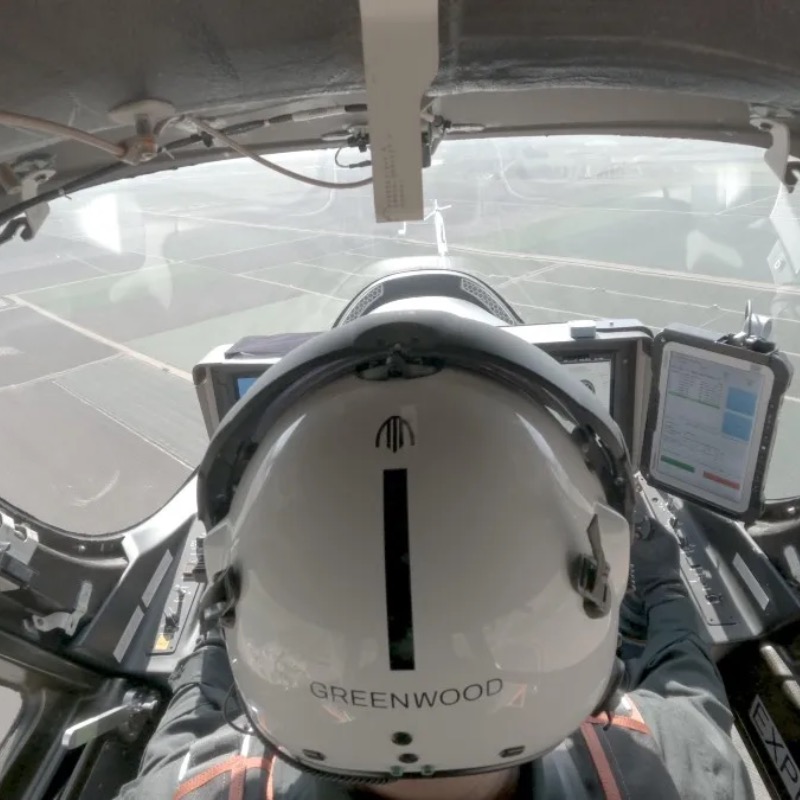By Anthony Lam, Michael Verdon, Basem Wasef, and Jen Paolini
The Electric Air Revolution
After years of hype, aviation’s electric revolution has arrived. EHang’s EH216 is expected to be certified this year, the first of a half-dozen electric vertical-takeoff-and-landing (eVTOL) rotorcraft planning to enter the market in 2024 and 2025. A handful of more conventional-looking electric aeroplanes are aiming for certification at about the same time. Development programmes have been proceeding at breakneck speed for several years, with billions now being poured into the market by investors. Six of the leading companies have already gone public. But the runway to silent, zero-carbon aircraft will have bumps. In March, Beta Technologies, one of eVTOL’s early adopters, announced it was delaying the launch of its Alia-250 eVTOL and will instead seek certification for its electric conventional-takeoff-and-landing (eCTOL) CX300 in 2025. The company will pursue electric flight, founder Kyle Clark told MIT Technology Review, “but in a way that doesn’t require three or four miracles to happen at once,” referencing the regulatory uncertainties and technical challenges still facing the eVTOL world. (Beta is still seeking to achieve certification for the Alia-250 in 2026.)
Earlier, competitors Lilium and Joby pushed back projected certification dates to 2025, for different reasons, but there seems to be the largely unspoken belief that FAA certification might take until 2027 or 2028, because eVTOLs are unlike any other aircraft ever produced. The FAA remains vague, telling MIT Technology Review that “safety will dictate the certification timeline, but we could see these aircraft in the skies by 2024 or 2025”—note emphasis on “could.”
But even if it is delayed, nobody expects the revolution to fizzle. The smart view is that—with the 250-plus eVTOL hopefuls whittled down to a dozen survivors, vertiports in place, and improved battery technology—air taxis will be mainstream, criss-crossing urban centres everywhere, by 2030.
In the meantime, non-hovering electric aircraft will serve as a stepping stone. Beta’s CX300, having flown a total of 22,000 miles (35.4 kilometres), and Eviation’s regional commuter, Alice, which completed its first test flight last year, are targeting different segments but with the same zero-emissions goal.
Other firms are also designing regional electric aircraft. “We’re looking at an on-demand model that creates new city pairs,” says Greg Davis, Eviation CEO, noting there are 3,500 small airports with paved runways in the US. “You pick the time and location—like Uber for aircraft— and we’ll be there. We’ll connect areas serviced by train or ferry.”
Pipe dream? Perhaps. Critical? Absolutely. “If we don’t do anything about it, aviation will be the top producer of carbon emissions in transportation by 2035,” Clark says. “And we’re not going to let that happen—not on our watch.”

Large-Cabin Jet
Gulfstream G800
With a range of 8,000 nautical miles at Mach 0.85 and a top speed of Mach 0.925, the G800 goes toe-to-toe with Bombardier’s ultra-long-range Global 8000, but its cabin volume is roughly 14 cubic metres less than the Global, which slots it into the large-cabin category. The G800, expected to enter service in late 2023, made an impressive debut in June 2022 by completing its first non-stop international flight from Gulfstream’s headquarters in Savannah, Georgia, to the UK’s Farnborough Air Show. Beyond range and speed, it boasts other noteworthy stats: the four-zone configuration in its 14.3-metre cabin can seat 17 and sleep seven, while 16 oversize windows provide exceptional natural light. The G800 shares multiple technologies introduced on the flagship G700 (also entering service this year), including its Symmetry Flight Deck with active side-stick controls, dual heads-up displays with synthetic vision, low-cabin altitude—equivalent to approximately 3,000 feet (914 metres) while flying at 41,000 feet (12.49 kilometres)—and special ergonomic seating and lighting that adapt to time zones to mitigate jet lag.

In-flight Cuisine
VistaJet
The art and craft of food preparation is very different at 40,000 feet (12.2 kilometres). Onboard humidity drops to 20 per cent, compared to 45 per cent on the ground, desensitising taste buds so that the perceptions of salinity and sweetness both decrease by 30 per cent. To rectify this, most food providers overcompensate with extra sodium, sugar, and fat. VistaJet realised that haute cuisine can retain its appeal at altitude by using fresh, flavourful, high-quality ingredients—and by enlisting top-tier chefs to create signature menus for its flights.
The company recently extended its partnership with chef Nobu Matsuhisa, creating a signature dish—steamed salmon miso—for VistaJet clients. That supplements existing Nobu-conceived dishes such as yellowtail jalapeño, black cod with miso, and prime beef tenderloin, as well as sushi and vegan options that clients can order prior to their travels. While the Nobu moniker is great for name-dropping, what differentiates VistaJet from its competitors is its obsessive focus on upscale cuisine. Seasonal offerings feature recipes from a dozen other chefs and restaurants around the world specifically designed for high-altitude dining while tailoring the menus to the routes and cultures of its clients. The ethos extends to the cabin attendants, who are certified by the British Butler Institute in wines and spirits, with additional training in food preparation and service.

Versatile OEM
Textron Aviation
Among major OEMs in the general aviation industry, Textron Aviation is perhaps the most versatile of them all, manufacturing propeller planes as well as aircraft with jet engines. Textron Aviation owns three renowned brands—Cessna, Beechcraft, and Hawker. Of these, the main business-jet brand is Cessna, as Beechcraft and Hawker business jets are no longer in production, although Textron Aviation still services existing Hawker jets. Meanwhile, the Beechcraft label produces only propeller planes now.
All three brands have storied archives stretching back to the early days of aviation: the Cessna 172 Skyhawk, a propeller plane first launched in the 1950s, is still in production and is arguably the most successful aircraft in history with some 44,000 units sold; the Beechcraft Bonanza, in production since 1947, boasts the longest production run of any aircraft model; and during World War II, British Hawker Hurricanes were responsible for 55 per cent of enemy aircraft destroyed in the pivotal Battle of Britain.

Amphibious Aircraft
Icon Aircraft Icon A5
An aeroplane, a speedboat, or a sports car—well, how about all three? Icon Aircraft developed the Icon A5 from a clean-sheet, state-of-the-art design as a two-seater light-sport-category aircraft. Conceptualised from the ground up for adventure, the wings of this amphibious plane can fold back so that the aircraft can easily fit in a trailer, garage, or hangar, and be towed out in your SUV for your next flying excursion. First-rate engineering doesn’t end with the wings, either—the cockpit interior was originally designed by BMW’s Designworks, then later by Lotus Engineering—the same renowned company that helped develop the Tesla Roadster. Its exterior was likewise designed by the coveted Nissan and Infiniti lead designer Randy Rodriguez (who later joined Tesla). The Icon A5 is powered by Rotax engines developed by independent manufacturer Bombardier Recreational Products, and is powerable by both 100LL or unleaded 91-octane automobile fuel, so you can conveniently top up at an airport, a petrol station when it’s on a trailer, or at a marina.

Corporate Airliner
Boeing Business Jets
Both Boeing Business Jets and its aircraft are often abbreviated as BBJ, but a more fitting acronym for the latter might be TUFBT—“the ultimate form of business travel,” as that is more or less how many people refer to BBJ. It’s an apt moniker for a commercial airliner serving as someone’s private jet.
More than 260 BBJ aircraft have been sold since the company’s formation in 1996. What convinced these buyers that their billion-dollar-range price tag was worth it? Knowing that there are more than 10,000 Boeing commercial jetliners currently in service worldwide was likely a factor: If an aircraft maker provides nearly half of the world’s current airliner fleet, then it must be making good planes. And then there are the business and lifestyle benefits that come with owning a BBJ: the ability to travel non-stop between virtually any two cities in the world; the capacity to take large groups of family, friends, or employees on board (typically 19 to 50, depending on cabin layout); the commodious cabin space that can be fitted out with all the amenities of an actual home or office, such as a gym, shower, kitchen, conference room, game room, bedrooms… BBJ makes all of this a delightful possibility.
The current BBJ product line draws from the 737 Max, 787, and 777X Boeing airliner families. At 76.7 metres long with a wingspan of 71.8 metres, the new BBJ 777-9 is the largest model in the line-up. Now, the only question remains: Will it be big enough for you?

Fixed-base Operator
Tag Aviation Macau FBO
Managed by Geneva-based TAG Aviation—a globally respected brand with 50-plus years of history—the modern and professionally staffed TAG Aviation FBO in Macau is a key layover destination for private aviators in the APAC region. Facilities at the Macau FBO include VIP, executive, and crew lounges, as well as conference rooms, nap rooms, and shower facilities. On-site customs and immigration clearance, luggage handling, transportation and accommodation arrangements, and flight-plan filing are among the services offered to passengers and crew. TAG Aviation Macau FBO also provides toilet and water service, passenger steps, luggage conveyor belts, refuelling service, and hangarage access. Maintenance is one of TAG’s core businesses, and the Macau FBO offers line maintenance for several Bombardier and Gulfstream models, as well as oxygen and nitrogen service, exterior and interior cleaning, and brightwork polishing.
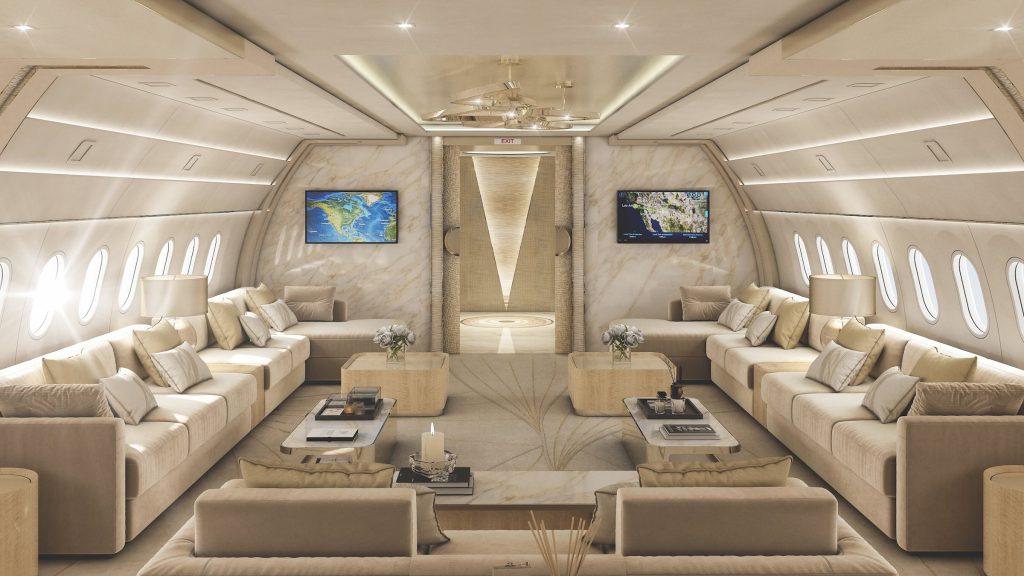
Interior Concept
Boeing 787-800 by Massari Design
Transforming the interior of a jet—even one as voluminous as the wide-bodied Boeing 787-800, which can carry 330 passengers in its commercial form—into a luxury suite requires both artistic and technical prowess. Massari Design’s contemporary take, including a marble-floor entrance and central-mosaic inlay with four columns, is the most inventive aviation interior concept in the past year. Even better news: The client is so pleased with the drawings that the fantasy promises to soon become reality.
The Italian studio used a rich but understated palette of champagne and beige hues, without going too bright or too bold. Low credenzas, lamps, and sculptures in front of oblong aircraft windows make it feel more like an apartment than a jet, while the back-to-back flat-screen televisions form a subtle barrier between the social and dining areas. Back-lit valance panels and the judicious use of leather, metal, woods, and fabrics bolster the refined ambience.
The underlying genius of this interior is that every material was engineered to meet strict FAA weight and flammability requirements but still performs as sumptuously as those found in a superyacht. The only man-behind-the-curtain moment happens when you turn around in the foyer and see the door, unmistakably that of a 787. Otherwise, the illusion of a penthouse in the sky is perfect.
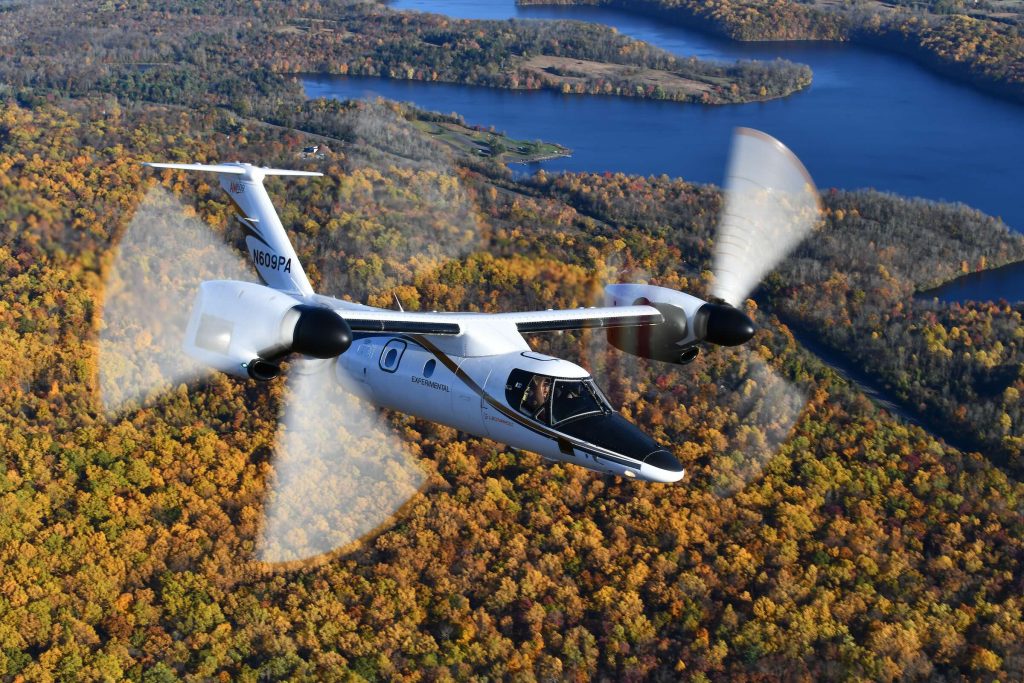
Crossover Aircraft
Leonardo AW 609 Tiltrotor
The Leonardo AW 609 Tiltrotor’s roots actually reach back two decades to the Bell Boeing V-22 Osprey, though you’d be hard-pressed to find similarities. The Bell Boeing team started the design of an analogous aircraft, the BB609, for the commercial market, and the evolution continued with a Bell/Agusta model, which morphed into an Agusta Westland version, and was reimagined yet again by the Italian aerospace firm Leonardo, with improved aerodynamics, upgraded engines, new landing gear, and Collins Fusion avionics.
Convoluted lineage aside, the AW 609 offers a compelling combination of the tried-and-true and the truly innovative: Twin PT-6 turboprop powerplants produce a reliable 1,940 shaft-horsepower each, while the cabin provides the comfort one would expect in an executive helicopter with a speed and range closer to that of a fixed-wing aircraft. Thanks to a pressurised cabin, the AW 609 can cruise at higher altitudes for smoother flight, while its vertical takeoffs and landings introduce new levels of point-to-point flexibility. Case in point: Rather than flying by helicopter from the New York City Heliport to New Jersey’s Teterboro Airport to board a plane for Washington, DC, you can travel the entire route via this tiltrotor in about an hour. The AW 609’s potential extends beyond luxury to other applications such as search and rescue and offshore exploration, allowing it to live up to the multi-mission potential its original designers envisioned.

Super-Midsize
Cessna Citation Longitude
Cessna introduced its first jet aircraft way back in 1969 and, in later years, the company’s jets became closely identified with its “Sure Thing” slogan, reflecting their reliability and piloting-friendly design. With its latest model, the Citation Longitude, Cessna has delivered yet another sure thing—and this one boasts increases in size, cabin comfort, and performance metrics.
Your Cessna Citation Longitude will easily fly you and your guests non-stop from, say, Singapore to Sydney, cruising comfortably at a speed of Mach 0.8 and carrying up to 12 passengers, who enjoy ample leg room and fully reclinable seats. Sleep is also made easy by what Cessna and independent reviewers say is the quietest cabin of any jet in the category. A wet galley is situated at the front of the cabin, while a spacious restroom in the back has a door that opens to a walk-in luggage space that is accessible while flying.
Comfort is further enhanced by an air circulation system that allows a constant stream of heated fresh air from outside to mix with recirculated air pushed through HEPA filters, and a cabin pressurisation system that keeps the interior feeling like you are at an agreeable 5,950 feet (1,813 metres) even when the aircraft reaches its maximum operating ceiling of 45,000 feet (13.72 kilometres).
Seating and other aspects of the cabin interior can be configured to suit your taste. Cessna offers six stunning pre-set interior designs that expertly blend materials and colours, including the warm and classic Bisque, minimalist Glacier, and power-projecting Jet Black, or you can choose to collaborate with the Cessna team to create your own design from scratch.
With a maintenance interval of 800 hours or 18 months, whichever comes first, the Citation Longitude has what Cessna claims is the lowest operating cost for its class—roughly US$2,455 (HK$19,200) per hour. With a list price in the US$20 million (HK$156.4 million) range, the jet is likewise competitively priced for its category. Overall, the Citation Longitude offers excellent range, high comfort, and an attractive cost structure—that’s enough to make it a sure thing for many.
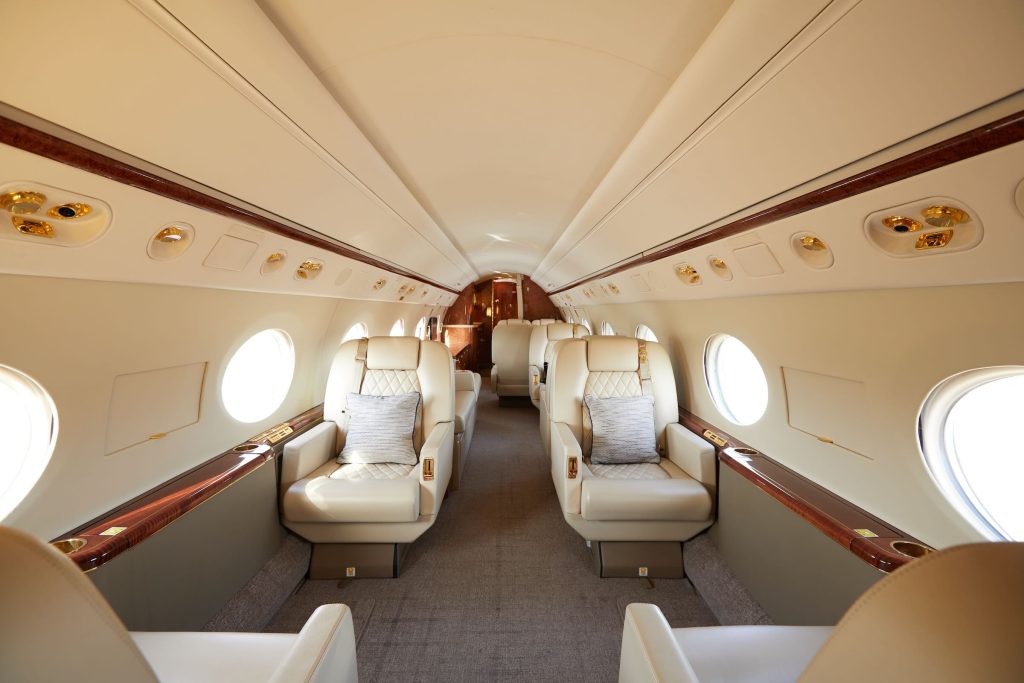
Shared Lease Programme
Amber Aviation
Incorporated in 2017, Amber Aviation has rapidly expanded to become a one-stop-shop aviation provider that offers a full range of bespoke solutions covering aircraft management, flight operations support, aircraft maintenance, and charter. Headquartered in Shenzhen, the company has branch offices in Beijing and Shanghai and wholly-owned subsidiaries in Hong Kong and Macau. After receiving investment and a number of Gulfstream G450 jets from leading US jet-card service NetJets, Amber expanded its self-owned fleet to 20 aircraft and began offering access to these jets through a shared lease programme—the first in China—and a traveller’s membership service, branded together as AmberNet. AmberNet’s one-year shared leases come in two versions: one offers 50 hours of guaranteed jet access with just 24-hour notice, and the other 25 hours of guaranteed access requiring 48 hours’ notice. Members enjoy complimentary ferry flights, reduced rates when chartering an AmberNet aircraft, and other perks.

Ultra-Long-Range Business Jet
Bombardier Global 8000
If there’s a single metric that defines an ultra-long-range business jet, Bombardier’s Global 8000 flaunts it right there in the model name: Its 8,000-nautical-mile range delivers impressive city pairings like Houston-Dubai, Los Angeles-Singapore, and London-Perth. Unveiled last year, the Global 8000 was engineered with the goal of becoming not just the long-distance leader but also the fastest and most comfortable. While its official top speed is Mach 0.94, the 8000 flew at Mach 1.015 during tests, making it the fastest civil aircraft since the supersonic Concorde. Inside, the cabin offers amenities including Pür Air advanced HEPA filters and Soleil circadian lighting to combat jet lag. Because passengers spend long hours seated, Bombardier’s Nuage seats feature thoughtful ergonomic details and a zero-gravity position for restful sleep when crossing date lines. Cabin pressurisation, which feels like 2,900 feet (884 metres) when the plane is cruising at 41,000 feet (12.49 kilometres), undercuts the competition by a hair but still enables Bombardier to claim the industry’s lowest figure. The Global 8000 is expected to enter the market in 2025.
. . . AND OUR BEST COMMERCIAL AIRLINES OF THE YEAR

Shower Spa
Emirates Airbus A380 First Class
Emirates’s first-class cabin and service are synonymous with in-flight luxury, and while the Middle Eastern airline’s well-established A380 suite is not as high-tech as the newer 777 Game-Changer suite, what it does have is the iconic shower spa, famously the first such walk-in bathroom in commercial aviation (and it’s still impressive to this day). Pay a visit to the onboard lounge, featuring a fully stocked bar, snacks, and social atmosphere, to while away the hours on a long-haul flight. A chic Bulgari amenities kit, organic toiletries by Voya, and skincare by Byredo complete the self-care and wellness offerings; there’s also the multi-course menu, served on Royal Doulton tableware with flutes of Dom Pérignon to pair.

Comfort
Cathay Pacific Boeing 777-300 First Class
Hong Kong’s home airline has experienced its fair share of ups and downs in recent years, but first-class travel remains an excellent affair thanks to attentive service, premium amenities, and a diverse dining programme. Its onboard cellar stocks wines and spirits from prestigious producers, as well as the Betsy beer, brewed specifically to be enjoyed at cruising altitude. Cathay Pacific considers its beds to be the “softest in the skies,” and it’s easy to see why: Organic brand Bamford supplies the 600-thread-count bedlinen, and the thick mattress and plush pillows work together to create a serene snoozing experience. A do-not-disturb service and Bose noise-cancelling headsets ensure that guests can catch plenty of uninterrupted Zs.

New Launch
Japan Airlines Airbus A350-1000 First Class
In a bid to strengthen its international service in a big way, Japan Airlines has earmarked a significant investment for enhancing its first-class cabin aboard the company’s new fleet of A350-1000 aircraft, designed to offer more exclusivity, comfort, and privacy than ever before. Spread across a 1-1-1 configuration, the individually enclosed suites each come with a 123-centimetre-wide seat-and-sofa setup that stretches flat into a two-metre-long bed, as well as an innovative speaker system built into the headrest so travellers can enjoy in-flight entertainment without headphones. Say goodbye to bulky overhead storage bins—a nifty wardrobe space inside the suite makes personal belongings easily reachable.
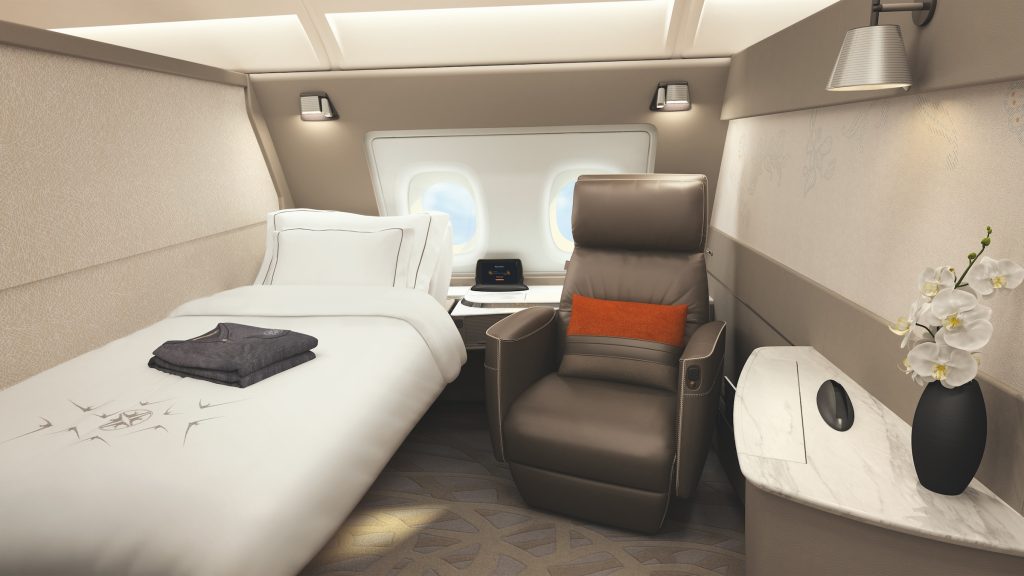
Space
Singapore Airlines Airbus A380 First-Class Suites
Singapore’s flag carrier has long been a leader in commercial aviation, scooping up accolade after accolade, so it should come as no surprise that the airline offers enviable options to those travellers seeking privacy and comfort on their flights. Designed by Pierrejean Design Studio, each of the six A380 suites is equipped with a fully flat bed or a double bed for couples travelling together, a Poltrona Frau-upholstered leather recliner that swivels, Bang & Olufsen noise-cancelling headphones, and a touchscreen monitor. Meals are served on Wedgwood china, and toiletries are from Lalique. Is the journey too short to finish watching your bookmarked films? KrisFlyer members can simply save their playlists for the next flight.

Multi-room
Etihad Airways Airbus A380 The Residence
For an experience that’s significantly more “sanctuary in the skies” than “transit from point A to point B,” Etihad Airways provides an elegant solution—its three-room Residence aboard the Airbus A380 comprises a spacious living room with a leather sofa, flat-screen television, and dining table; a double bedroom with a wardrobe and second entertainment system; and an en-suite bathroom complete with a full-height shower. Gourmet à la carte dishes can be had when the fancy strikes, and guests can further enjoy other amenities such as luxury loungewear, toiletries, noise-cancelling headsets, and mobile connectivity. On the ground, chauffeur service and a dedicated team make the check-in process and journey seamless.









